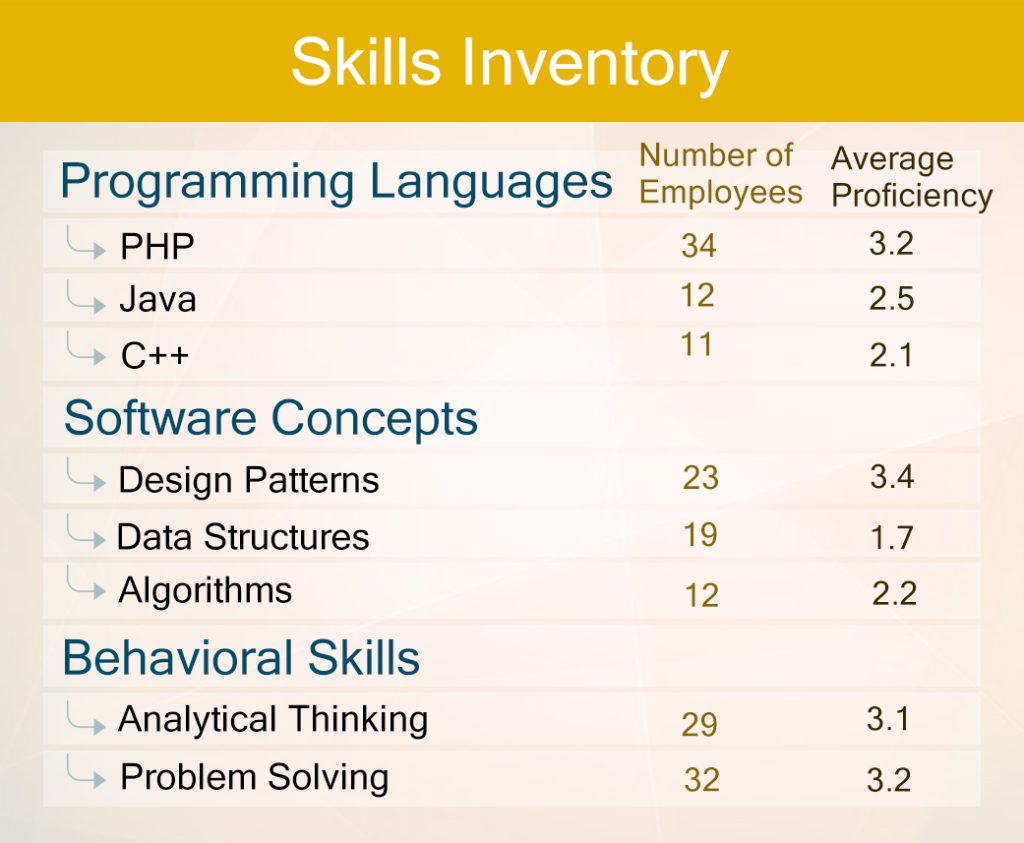Are you finding it harder to hire the right people for your growing organization? Don’t worry, you are not the only one! Over 60% of business leaders in the U.S. face the same challenge. Worldwide, recruitment firms cite “tight talent pools” as their main hiring challenge (at 56%).
Now the question is, why is this happening – and what’s the underlying problem? According to the latest studies, most organizations simply hire a suitable candidate – based on their years of experience in a particular job role. This is a flawed approach. In all probability, even experienced candidates may not possess the core skills required to perform the job for which they were selected.
So, what should recruitment managers do? Here’s a 2-step hiring process:
- Identify the core skills that they need to perform the job.
- Ensure that the hired recruit has all these skills.
Sounds quite simple, isn’t it? Not so much.
The challenge is that the skills required to perform the same job keep changing over time. 25% of skills have changed since 2015. This is why hiring companies need skills taxonomy in today’s competitive job market. Simply defined, skills taxonomy is an inventory of skills that are relevant to your organization.
In this blog, we shall explore skills taxonomy, its importance, and its benefits for modern companies.
Understanding Skills Taxonomy
A skill taxonomy stands for an exhaustive, all-encompassing structure of a variety of job skills spanning different industries. Primarily, a skill taxonomy has 2 categories of skills, namely:
- Hard or technical skills – such as software development, machine learning, and business intelligence.
- Soft skills – such as interpersonal communication, team building, and critical thinking.
So, how does skills taxonomy differ from traditional competency models? A competency model is essentially a traditional mode of tracking a job candidate’s abilities. It is a more “role-centric” model that focuses on the candidate’s behavior and other abilities to perform a particular job.
On the other hand, a skills taxonomy focuses on – you guessed it right! – the candidate’s specific skills to perform a job.
As compared to skills taxonomy, the competency model becomes quickly outdated – when the same job requires a new skillset. Needless to say, the skills taxonomy model is easier to update with new skills. Still not grasped the concept? Here’s an example:
Let’s say you are evaluating the resume of a software engineer who worked with Google in the 2000s. The skills taxonomy platform would determine the engineer’s skillset based on their Google work experience and LinkedIn connections.
For instance, if Google was working on developing its machine learning technology (during the same period), the skills taxonomy would add “machine learning” as the candidate’s core skill.
On the other hand, the competency model would merely identify the candidate’s abilities as a “software engineer” or for “search optimization.”
The Critical Role of Skills Taxonomy in Modern Enterprises
Why is skills taxonomy critical for modern enterprises? Skills taxonomy will remain critical as long as skillsets for various jobs continue to change. 9 out of 10 L&D professionals agree that tracking skills to upskill (or reskill) their workforce is necessary to meet changing job demands.
Besides hiring more employees, companies need the right talent to perform the existing job – and adapt to new emerging jobs.
With its skills-based approach, a skills taxonomy breaks down a job requirement into multiple skills – and then hires the individual who has those skills. For example, a web developer may possess the following skills:
- HTML and CSS
- WordPress
- Javascript
- Frontend and/or backend web development frameworks
As more companies implement digital transformation to stay competitive and relevant, skills taxonomy can help them meet their skills requirements to implement digital transformation projects.
Effectively, a skills taxonomy provides a framework (with the following components) to categorize their identified skills:
- Skills hierarchy
This component refers to a group of related skills organized in a hierarchical structure. For example, a skills hierarchy for sales executives can include skills like sales, product knowledge, customer relationships, and communication.
- Skills name and description
This component provides a consistent name and description that helps you understand the identified skill. For instance, the skills inventory for a software engineer can include names like coding, debugging, programming languages, and teamwork.
- Skills map
This component adds more relevance to the available skills – and helps in driving business decision-making. Additionally, it enables organizations to identify skill gaps (in their current workforce) and the skills that they need to hire.
- Skills cluster
This component refers to a group of related (or overlapping) skills. For example, a skills cluster in teamwork could include related skills like team collaboration, communication, and team building. Skills clusters are important to identify opportunities for upskilling and reskilling.
5 Key Benefits of Implementing Skills Taxonomy
Here are 5 major benefits for organizations implementing skills taxonomy:
- Enhancing the Hiring Process
Modern companies must focus on developing a skills profile required for their internal teams. For example, the skills profile of a project manager would comprise skills like project management, budget management, time management, and reporting.
By implementing skills taxonomy, organizations can leverage their Skills Profiler tool to create and map their skills profile. The skills profiler can enhance the hiring process by addressing the following questions:
- Do the desired skills already exist in the organization?
- If yes, then can the personnel (with that skillset) be readily assigned to the new job?
- Is there ample scope to train the existing workforce on the required skills?
- Can you expand the job role to address any skills gap?
- Optimizing the Internal Recruitment Process
Skills taxonomy enables companies to identify potential employees for future growth and development. Organizations can save hiring costs in today’s competitive job market by optimizing the internal recruitment process. This also helps in building a healthy organizational culture.
Career-focused employees can leverage skills taxonomy to develop their skills for their current jobs and higher positions in your organization. A skills taxonomy also acts as a guide to demonstrate their learned skills and competency.
With an optimized internal recruitment process, HR managers can also plan their upskilling and reskilling programs. In the long run, skills taxonomy enables organizations to move towards a more “fluid” workforce – with the ability to fill the skills gap and quickly assemble a project team (with the necessary skillset).
- Bridging the Skills Gap
Among its primary benefits, skills taxonomy enables organizations to identify skills gaps between individual employees and jobs. This is because skills taxonomy allows companies to view their available skills at a granular level. With this tool, companies can get a bird’s eye view of their skills. Competency models cannot help them “plug” these skills gaps.
Besides identifying skills gaps, the model can resolve this problem by empowering companies to maximize their L&D investment by:
- Assessing the proficiency of the available skills.
- Identifying upskilling opportunities for the right personnel or team – in line with business objectives.
With a Skills Analytics tool, organizations can now:
- Map and manage their skills profiling (based on role or employee).
- Perform a skills gap analysis to identify the skills gap.
- Identifying Targeted Learning Opportunities
Organizations adopting skills taxonomy can leverage it to create a targeted learning program for their business needs. L&D courses can be developed based on the skills they provide – as well as how various teams can benefit from the identified skill sets.
To identify targeted learning opportunities, L&D teams must work closely with functional teams and identify their training needs. HR systems can also track and measure available skills across their organization by using this.
HR teams also have the updated data to:
- Identify and map skills gaps.
- Develop focused training programs to address these skills gaps.
- Build the existing skills and competencies.
- Boosting talent retention
In a competitive job market, companies are struggling to retain the right talent. High-value employees are constantly planning their next career move. Talent retention can save companies valuable hiring and training costs. Companies can retain more talent with focused training programs aimed at skill development. Regular training also leads to higher job satisfaction and loyalty.
Skills taxonomy also encourages internal mobility as companies can recruit talent from their in-house talent pool. With this, organizations can address mobility-related questions like:
- Can a particular skill be used outside the current project?
- Are there ample opportunities to train employees for other job roles?
- Do senior employees have leadership and mentorship skills to guide new hires?
Conclusion
As discussed in this blog, an efficient skills taxonomy is crucial for organizations to navigate the complexities in their hiring process. Due to the changing demands of current jobs, this skills-based approach is better suited than the traditional competency model.
At IYS, we believe that skills are the currency of human capital. We can help transform your recruitment and L&D process with a range of services, including:
- Skills taxonomy
- Skills profiling
- Employee/ Candidate skills analytics
Are you planning to implement skills taxonomy in your organization? We can help you get there quicker. Just connect with us at connect@itsyourskills.com.





